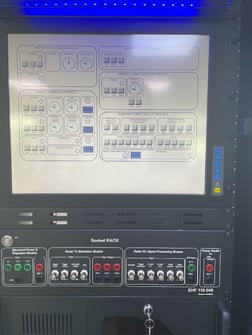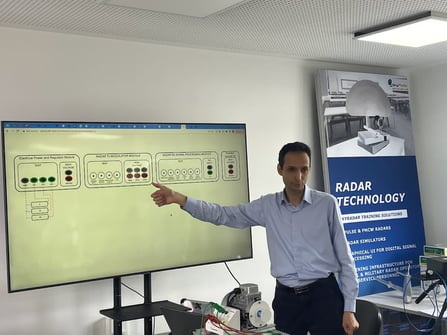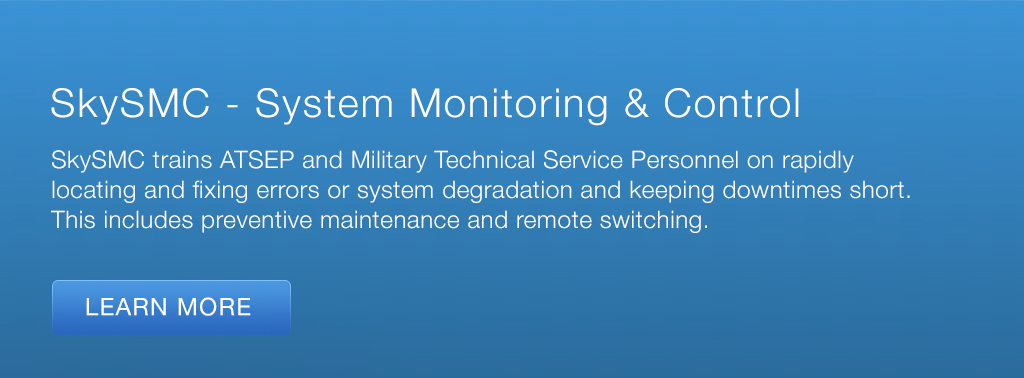In this article we will define processing errors due to delay explain the impact of transmission errors related to delay on air traffic control services and provide steps to be taken by ATSEP (Air Traffic Safety Electronics Personnel) in rectifying processing errors related to delay and preventing delays.
Air Traffic Control (ATC) plays a vital role in ensuring the safety and efficiency of air travel. The primary function of ATC is to manage the flow of aircraft in the sky and on the ground to prevent collisions and maintain the orderly flow of air traffic. One of the key challenges faced by ATC is managing the high volume of data and communication that is required to coordinate the movement of aircraft. Processing errors due to delay can have significant implications for air traffic control services.
Definition of Processing Errors due to Delay
Processing errors due to delay refer to errors that occur when there is a delay in the processing of data or communication. These errors can be caused by a variety of factors such as technical issues human error or environmental factors. When these errors occur in the context of air traffic control services they can have serious implications for the safety and efficiency of air travel.
What is Delay
Delay refers to the time it takes for data or communication to be processed. In the context of air traffic control services delays can occur at various stages such as when a pilot communicates with ATC or when ATC processes information related to an aircraft's position or flight plan. Delays can be caused by a variety of factors such as technical issues congestion in the communication network or environmental factors such as weather conditions.
Example Related to ATSEP and Air Traffic Control Service
Consider an example where an aircraft is approaching a busy airport and the pilot contacts ATC to request landing clearance. However due to a technical issue the communication between the pilot and ATC is delayed by several seconds. As a result the pilot may not receive clearance to land at the desired time which can cause the aircraft to circle the airport creating congestion in the air and potentially delaying other flights. This delay can have a ripple effect causing further delays and creating a domino effect that can impact the efficiency of the entire air traffic control system.
Scenario Illustrating the Impact of processing Error due to Delay on Air Traffic Control Services
Scenario 1: The System Time Synchronization Error
In a bustling air traffic control center a critical software update was implemented to improve the accuracy of flight scheduling and reduce delays. The update included a component that synchronized the system time across various applications and devices used by air traffic controllers.
However a processing error occurred during the implementation causing a time synchronization discrepancy among the systems. The error went unnoticed initially but its impact quickly became apparent. The air traffic control system started recording incorrect timestamps for flight events leading to inaccurate estimations of arrival and departure times.
As a result air traffic controllers received conflicting information about flight schedules and sequencing. Flights were inadvertently delayed or expedited based on incorrect time data causing disruptions in the flow of air traffic. Pilots received conflicting instructions leading to confusion and potential safety risks.
The processing error had a domino effect throughout the air traffic control services. Delays increased as controllers struggled to reconcile conflicting information and manually adjust flight schedules. Passengers experienced frustration and inconvenience due to missed connections and extended travel times. The incident highlighted the importance of robust time synchronization processes and thorough testing before implementing critical software updates.
Scenario 2: The Communication Delay Glitch
In another air traffic control center a newly integrated communication system was intended to improve coordination between air traffic controllers pilots and other stakeholders. The system aimed to facilitate real-time information exchange enabling efficient decision-making and minimizing delays.
However an unforeseen processing error plagued the communication system. Messages sent between air traffic controllers and pilots experienced significant delays in transmission. Important instructions clearance requests and critical updates took longer than usual to reach the intended recipients.
The impact of this processing error was far-reaching. Air traffic controllers struggled to maintain effective communication with pilots leading to misunderstandings and misinterpretations. Clearance requests were delayed causing flights to remain grounded or held in holding patterns unnecessarily. Flight schedules were disrupted and delays cascaded throughout the airspace.
Passengers were the ultimate victims of the processing error. Their travel plans were upended and frustrations mounted as flights experienced extended delays and missed connections. The incident prompted a thorough investigation into the communication system revealing the need for enhanced redundancy and fail-safe mechanisms to mitigate processing errors and ensure timely and reliable communication.
These scenarios demonstrate how processing errors related to "Delay" can have profound consequences on air traffic control services resulting in disruptions safety risks passenger inconvenience and increased workload for controllers. They underscore the importance of rigorous testing thorough quality assurance processes and continuous monitoring to identify and rectify processing errors before they impact operational systems.
Impact of processing errors related to delay on air traffic control services
Processing errors related to "Delay" can have significant impacts on air traffic control services. Delay is a critical aspect of air traffic management and errors in processing delay information can result in various consequences
Flight disruptions
Processing errors can lead to incorrect or inaccurate delay information being communicated to air traffic controllers pilots and airlines. This can result in flight disruptions such as unexpected delays missed connections or even flight cancellations. Passengers may experience inconvenience and frustration due to extended waiting times or disrupted travel plans.
Increased workload for air traffic controllers
Processing errors related to delay can place an additional burden on air traffic controllers. They must handle the increased number of delayed flights manage revised schedules and coordinate with airlines and pilots to minimize the impact of delays. This can lead to heightened stress levels and a higher risk of human error if the workload becomes overwhelming.
Congestion in the airspace
Delay errors can contribute to congestion in the airspace. When flights experience unexpected delays or changes in schedules it can disrupt the optimal flow and sequencing of aircraft. Congestion can lead to increased separation requirements reduced efficiency and potential safety risks if controllers struggle to manage the increased volume of delayed flights.
Reduced efficiency and increased costs
Processing errors related to delay can undermine the efficiency of air traffic control services. Airspace capacity may be underutilized due to delays leading to increased fuel consumption and operational costs for airlines. Inefficient utilization of resources can result in longer flight durations increased emissions and additional expenses for the aviation industry as a whole.
Safety risks
Errors in processing delay information can introduce safety risks. For instance if delays are not properly communicated or coordinated it can lead to conflicts between aircraft during approach departure or taxiing. Pilots may receive inaccurate information about the availability of runways or the sequencing of aircraft potentially increasing the risk of runway incursions or other incidents.
Impact on airport operations
Processing errors related to delay can also affect airport operations. Inaccurate delay information can disrupt ground handling services baggage handling processes and other airport operations that depend on timely and accurate flight scheduling. This can lead to inefficiencies increased costs and potential disruptions in overall airport functioning.
To mitigate the impact of processing errors related to delay on air traffic control services robust systems for capturing and processing delay information are crucial. Regular quality checks thorough testing and effective communication protocols between air traffic controllers airlines and airports can help minimize the occurrence of processing errors. Additionally investing in advanced technologies such as data analytics and predictive modeling can enhance the accuracy of delay predictions and enable proactive measures to manage and mitigate delays effectively.
Steps to be Taken by ATSEP in Rectification of Processing Errors Related to Delay
When processing errors due to delay occur it is essential for ATSEP to take prompt and effective action to rectify the situation. The following are the steps that can be taken by ATSEP to rectify processing errors related to delay:
Identify the source of the delay
The first step in rectifying a processing error related to delay is to identify the source of the delay. This can involve analyzing the communication system and identifying any technical issues that may be causing delays.
Notify the relevant parties: Once the source of the delay has been identified ATSEP should notify the relevant parties such as the air traffic controllers and pilots of the issue and provide an estimated time for resolution.
Implement a solution
ATSEP should work to implement a solution to resolve the delay as quickly as possible. This may involve repairing technical issues optimizing communication systems or implementing contingency plans to manage the impact of the delay.
Monitor the situation
Once a solution has been implemented ATSEP should monitor the situation closely to ensure that the delay has been resolved and that there are no further processing errors due to delay.
Steps to be Followed by ATSEP for Preventing Delay
To prevent processing errors due to delay from occurring in the first place ATSEP can take several steps including:
Regular maintenance of communication systems
Regular maintenance of communication systems can help prevent technical issues that may cause delays from occurring
Optimization of communication systems
ATSEP can optimize communication systems to ensure that data and communication are processed as quickly and efficiently as possible.
Implementation of contingency plans
ATSEP can develop and implement contingency plans to manage the impact of delays if they occur.
Training and education
ATSEP can provide training and education to air traffic controllers and other personnel to help them recognize and manage processing errors related to delay.
Factors Responsible for Delay-Related Processing Errors and Explanation of Each Factor
Several factors can contribute to delay-related processing errors including:
Technical issues
Technical issues such as hardware failures software glitches or network congestion can cause delays in data processing and communication.
Human error
Human error such as miscommunication or incorrect data entry can also cause delays in data processing and communication.
Environmental factors
Environmental factors such as weather conditions or natural disasters can cause delays in data processing and communication.
Congestion
Congestion in the communication network or airspace can also cause delays in data processing and communication.
Common Types of Processing Errors Caused by Delay and Explanation of Each Error
Some common types of processing errors caused by delay include:
Data entry errors
Delay in data processing can result in data entry errors such as incorrect flight information or incorrect routing information.
Miscommunication
Delay in communication can result in miscommunication between air traffic controllers and pilots leading to misunderstandings and errors.
Collisions
Delay in processing information related to aircraft position can lead to collisions or near-miss incidents.
Congestion
Delay in communication or data processing can cause congestion in the airspace or airport leading to delays and disruptions in air traffic control services.
How to Prevent Processing Errors Due to Delay
Preventing errors due to delay requires a multi-faceted approach that involves technical solutions contingency planning and training and education. The following are some ways to prevent errors due to del ay
System Design and Architecture
During the system design phase, it is important to consider the impact of delays on processing and implement a design that minimizes potential errors. This includes designing efficient algorithms, optimizing data flow, and considering buffering or queuing mechanisms to handle delays effectively.
Performance Monitoring
Implement monitoring mechanisms to track the system's performance, including response times and processing delays. This allows for timely detection of delays and identification of potential bottlenecks or issues that may lead to processing errors.
Real-Time Data Processing
If real-time processing is critical, ensure that the system is capable of handling data in a timely manner. This may involve implementing parallel processing techniques, optimizing algorithms, or using specialized hardware or software solutions designed for real-time processing.
Load Balancing and Scalability
Implement load balancing mechanisms to distribute the processing workload evenly across system resources. This helps prevent delays and overloads on specific components, minimizing the chances of processing errors due to delays. Additionally, ensure that the system can scale and handle increased loads to maintain optimal performance.
Network Optimization
If the processing involves communication across a network, optimize network infrastructure and protocols to reduce latency and minimize delays. This may involve optimizing network configurations, implementing caching mechanisms, or using compression techniques to reduce data transmission times.
Prioritization and Scheduling
Prioritize critical processing tasks to ensure they receive immediate attention and are not delayed by lower-priority tasks. Implement scheduling algorithms that allocate resources efficiently and consider the urgency or importance of different processing tasks.
Error Handling and Retry Mechanisms
Implement error handling mechanisms that can detect and handle processing errors due to delays. This may involve implementing retry mechanisms for failed or delayed processing tasks, incorporating error recovery procedures, or providing appropriate notifications or alerts for critical errors.
Testing and Validation
Conduct thorough testing and validation of the system to identify and address potential processing errors caused by delays. This includes simulating different load scenarios, stress testing the system, and analyzing performance under various conditions to ensure its robustness and reliability.
Regular Maintenance and Updates
Perform regular maintenance and updates to address any issues related to delays or processing errors. This includes applying software patches, optimizing system configurations, and addressing any identified performance bottlenecks or inefficiencies.
Continuous Improvement
Foster a culture of continuous improvement by actively seeking feedback from system users and stakeholders. Regularly evaluate the system's performance, collect user feedback, and incorporate lessons learned to enhance processing efficiency and minimize the occurrence of errors due to delays.
Conclusion
Processing errors due to delay can have significant impacts on air traffic control services leading to congestion delays and disruptions that can impact the safety and comfort of passengers and increase costs for airlines and air traffic control services. ATSEP play a critical role in managing and resolving processing errors related to delay and there are several steps that can be taken to prevent these errors from occurring in the first place.
Regular maintenance and optimization of communication systems implementation of contingency plans training and education use of advanced technologies and effective collaboration and communication are all essential for preventing and managing processing errors due to delay. By taking these steps ATSEP can help ensure the safety efficiency and reliability of air traffic control services minimizing the risk of potential incidents and disruptions.
SkyRadar's System Monitoring & Control Solution
SkySMC - SkyRadar’s System Monitoring and Control Suite is a pedagogically enhanced, fully operational monitoring & control tool. It has been designed to practice these use cases. We have optimized it to host ATSEP training in SUR, NAV, COM, DPR and SMC compliant to EASA's Easy Access Rules for ATM-ANS (Regulation (EU) 2017/373) and ICAO Doc 10057.
SkyRadar provides SkySMC as a complete laboratory in a turn-key approach, or as a virtual infrastructure (for purchase or as a service).
SkySMC is not a simulator, but a fully operational open monitoring system. It comes by default with a server including various virtualized applications and virtualized servers, but also connects to simulated systems. In addition, there are various hardware extensions available including training infrastructures, monitorable training radars, or even complete ATM systems, all connected to the System Monitoring & Control solution. Most components such as the radars, it IT infrastructure or networks exist in hardware and software (virtualized or simulated).
The two photos above show the same trouble-shooting panel and socket rack in real hardware and in the simulator (fully functioning).
SkyRadar's System Monitoring & Control training system can be easily blended into distance learning solutions and existing learning management systems.
Let's talk
Stay tuned to be always the first to learn about new use cases and training solutions in ATSEP qualification (real radars or simulators).
Or simply talk to us to discuss your training solution.
References
- Federal Aviation Administration. (2021). ATSEP. Retrieved from https://www.faa.gov/about/office_org/headquarters_offices/ato/service_units/techops/ats/asep/
- International Civil Aviation Organization. (2019). Manual on the implementation of the safety management system. Retrieved from https://www.icao.int/safety/SafetyManagement/Documents/ICAO%20SMS%20Manual%20Doc%209865%20en.pdf
- National Air Traffic Services. (2021). ATSEP. Retrieved from https://www.nats.aero/careers/engineering/atsep/






